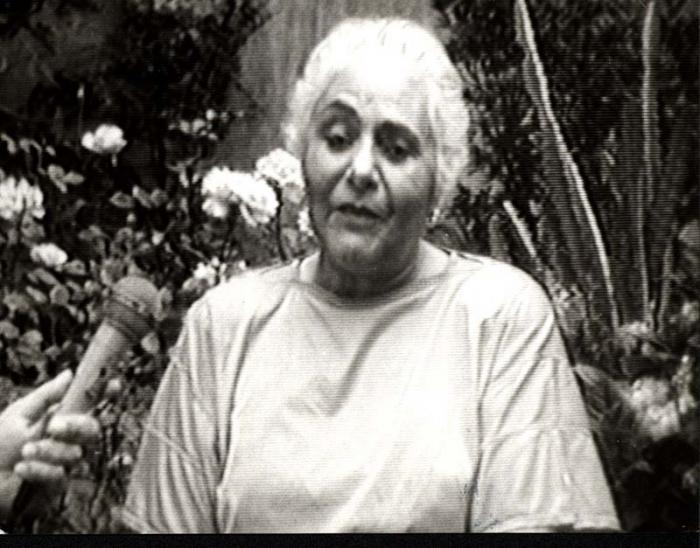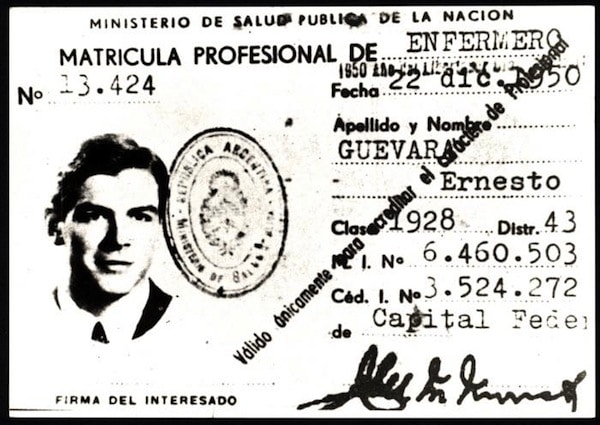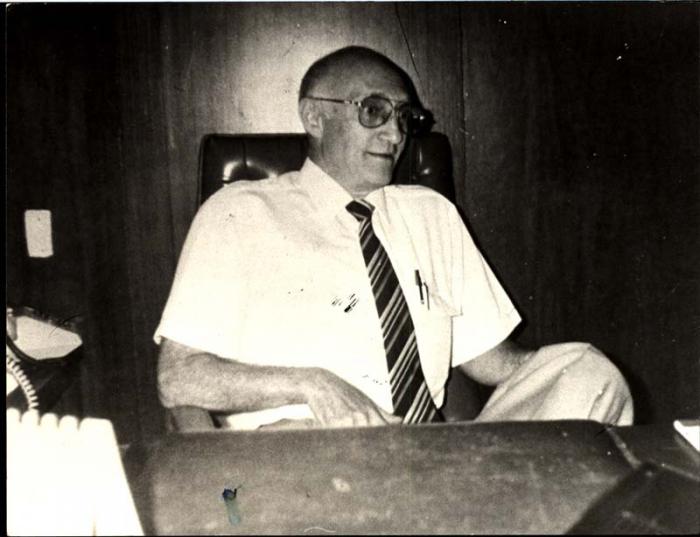Ernesto Guevara’s medical colleagues, both in Peru and Mexico, agree that he was profoundly interested in the social function of medicine, and that he had the makings of a researcher, although politics dominated his extraordinarily analytical mind.
From the early stages of the investigation of allergic diseases, attempts have been made to find a method that adequately indicates the antigenic action of the various allergens in contact with a specific human organism. The variety of tests conducted, both in terms of the means used and in their technique, is very broad, and the investigation of food sensitivities has seen, and has, periods of enthusiasm and indifference, depending on the countries and schools that test them.
… A few years ago, the Argentine researcher Salvador Pisani worked with semi-digested foods perfecting a technique that allowed him to obtain great therapeutic success and to substantiate a body of doctrine based on the importance of food sensitivities in the process of an allergic state.
Since the technique presented in this paper is based on everything known about Dr. Pisani’s research, with whom I collaborated for several years in Argentina, I will outline its fundamental concepts. The origin of the allergic state would be an abnormal arrangement of the mucosa of the digestive tract, whose hypermeability allows…
These fragments on scientific research related to allergies are from a paper presented by Dr. Ernesto Guevara de la Serna, a young Argentine physician, who had come from Guatemala and was at the time a resident in Mexico City, published in Volume II, No.4 (May, 1955), of the Revista Iberoamericana de Alergologia –Alergia, headed by the late Dr. Mario Salazar Mallén, an eminent Mexican physician who would soon become professor to the “Che” Guevara globally recognized today.
The newspaper and periodicals library of the Medical Society of the General Hospital of Mexico, where the young Argentine doctor Ernesto Guevara worked, preserves the originals of this and other research work carried out by Che.
During that time, he worked in both the General Hospital and the Institute of Cardiology, where Salazar Mallén led a research center.
Almost all the interns or residents studying under Dr. Mallén, alongside Ernesto Guevara, were or are renowned professionals. The same was the case with other colleagues of Che in Peru, where he studied the specialty of Leprology, as part of a group of scholars led by Dr. Hugo Pesce, a leading figure in tropical medicine, and a man of advanced political thought, a Marxist theorist, and friend and compañero of José Carlos Mariátegui.
Ernesto Guevara’s medical colleagues, both in Peru and Mexico, agree that he was profoundly interested in the social function of medicine, and that he had the makings of a researcher, although politics dominated his extraordinarily analytical mind.
In the residence of Montes Urales, Mexico City
“One day Ernesto told my husband, Dr. Salazar Mallén, ‘Professor… well, see you around.’ It was a very typical expression of his then, a farewell; and then he left on the Granma yacht with Fidel Castro.”
So recounted Olvido Tapia, Salazar Mallén’s widow, one of the acquaintances that we located in Mexico, when gathering information about the life of Ernesto Guevara in that city, where he joined the group commanded by Fidel.
Olvido Tapia welcomed us to her home in the elegant neighborhood of Montes Urales, the same that Ernesto frequently visited, and there she showed us her garden, and the chairs where the young Argentine would sit and discuss scientific and political issues with his professor.
Professor Salazar Mallén was devoted to his profession and he wanted Ernesto Guevara to devote himself to medicine just like him, in body and soul, because he believed, with good reason, that the kid had a great talent for research. My husband told me that ultimately he was unable to persuade him, and Ernesto confirmed it when he made his farewell remark. Later, when Mario learned of theGranma landing and the vicissitudes that Fidel, Ernesto, and they all went through, he was furious, really furious that he had not been able to prevent Ernesto from leaving. He said to me, ‘You see, that kid is not going to last, remember his asthma.’ But life proved Che right, as everyone called him, and not my husband.
Then, in 1959, 1960, Che called Mario by phone to consult him about medications and allergy problems. Mario also called him and informed him of how the investigations were going in that field; they remained great friends.
“Che invited him to Cuba to meet with the doctors there, he took him to visit places where he had fought as a guerrilla with Comandante Fidel Castro, and Mario brought to Mexico many photographs in which Che, his bearded helpers, his wife Aleida March appeared… But when Mario died a short time ago, I was tormented by memories and I ripped up many photos, letters and among those papers were also some related to Ernesto,” Olvido Tapia explained.
He was so fond of Ernesto that he made him accompany us on excursions, almost all related to events on his medical specialty, that were held in other states of the country. My daughter, then very little, and unfortunately also deceased, was fond of Ernesto and he of her. He would lift her up and walk long distances carrying her on his back, simply to please her in her childish interests; he was very friendly and respectful. When the professor talked to other people that Ernesto did not know, he immediately separated from the group, and if Mario did not call him, he didn’t take part in the conversation, even when he mastered the subject in question perfectly.

Olvido Tapia, widow of professor Salazar Mallén, in her home in Montes Urales, Mexico, where she spoke of the young Argentine doctor, Ernesto Guevara. Photo: Marta Rojas
We even invited him as soon as he arrived to live in this house, where there was space and comfort for him, but Ernesto refused. He said that it was not right for a student to live in the same house as his professor, that the teacher needed privacy and that there were certain distances to maintain; there was no way to convince him to come live with us, he preferred to stay in a sleeping bag on an examination table, in a small examination and instruments room in the hospital, until he had his own apartment.
Once Che Guevara, Ernesto dedicated a book of his to my husband. Mario was very proud. The dedication read: ‘To Dr. Salazar, a spirit open to every impulse, although an agnostic in terms of liberation wars, with the desire to convert him. Che, Havana, April 12/60.’
Dr. David Mitrani, friend of Ernesto
The quest to find Ernesto Guevara’s compañeros from the General Hospital and the Institute of Cardiology advanced following our encounter with Olvido Tapia; in her house we met David Mitrani, another of Salazar Mallén’s students, and one of Che’s closest friends.
“Do you remember, David, how Ernesto always carried my daughter Maria Eugenia astride ..?” Olvido asked Mitrani in a room of the house full of beautiful works of universal art, and other original pieces of Mexican cultural heritage.
We went almost every day to ‘taquear’ (eat tacos in the street). For a long time that was Ernesto’s and my main meal. Then I started in a furniture business and there I progressed economically, but I did not leave medicine. Ernesto, meanwhile, in those bad times, economically speaking, took photos and even worked as a journalist for an Argentine agency.
Dr. Mitrani’s testimony flowed and it was as if he were reliving those youthful years. The doctor made a leap forward in time and told us of his encounter with Ernesto when he was Comandante Guevara; they ate together in the offices of the National Bank of Cuba, which Che headed.
I was amazed to see him in his uniform and with his Comandante star. Che put a bottle of wine on the table and said: ‘I know that you are a bourgeois and I ordered to prepare a meal with wine for you.’ That was his fine irony.
Immediately David Mitrani’s thoughts returned to Mexico:
Che was just a year older than me. We were very young. I admired him, we all admired him in the hospital, because at the age of 24 he had been all over the Americas, he had participated in the ‘uprising’ in Guatemala… In short, because of his Argentine origin, what he told us sometimes seemed to us an exaggeration, but it was the pure truth: he had lived those years intensely, and here in Mexico as well. During the day he worked on his research, while at night he was an assistant professor in physiology at the old School of Medicine. He also took photos. On the other hand, he operated on dogs and cats for his investigations, and the interesting thing was that he was very mature in his things, and at the same time he seemed like a big kid; for example, as Mrs. Olvido said, he played with little María Eugenia. The two of us discussed international politics a great deal; he was very mature.
Ernesto Guevara had not concealed his encounter with the Cuban revolutionaries, and in particular with Fidel, from his friend David Mitrani. As he would tell us:
The day after Ernesto met Fidel, he came to see me at the hospital, very excited, really enthusiastic, and told me that he had met Fidel, a very agreeable and very intelligent person. Later, I met some Cubans whom I attended as a doctor in the hospital, at the express request of Ernesto. When he was taken prisoner he sent for me, he called me to ask for adrenaline; I personally took some vials to him, and the funny thing is that I arrived to the jail, and the first thing I find is Ernesto, Che, playing chess with one of the officers, with one of his jailers.
“But,” continued Mitrani, “returning to his interest in medicine, I will tell you that Ernesto worked very hard and very seriously, like everything he did; his investigative work was successful. As a young man he had resounding success because he was published in a specialized magazine. I remember at least two very sound papers about food antigens and the action of histamine in cats’ uteruses. He did the research alone and wrote the papers in the midst of his political concerns and the struggle to make a living, because he had already made a family.”
Olvido Tapia noted that Ernesto was an intellectually very well-trained young man and Mitrani offered an anecdote in this regard:
Ah, yes! At midday in the laboratory the professor (Salazar Mallén) had the habit of pausing his work and drinking coffee with us; during that time there was some reading of a classic, usually short stories by Mark Twain or Anton Chekhov. The professor asked his students to comment on what had been read and Ernesto, with that maturity and culture he had, always participated with enriching remarks. In the afternoons, when the work was finished in the laboratory, then it was his: we invited the girls and other colleagues and Che prepared two liters of maté tea, and we’d talk, debate heatedly…
Ernesto loved to prepare the maté and forced us to drink it with him, and we missed him when we no longer drank that maté. Then he and I would go out again to ‘taquear’ or to follow our respective individual interests.
The Alpinist: testimony of Dr. Bessudo
David Mitrani and Olvido Tapia provided us with the location of Dr. León Bessudo, one of the most renowned mountain climbing enthusiasts in Mexico, particularly fond of climbing the Popocatépetl volcano in the Sierra Nevada range, in Puebla, about 60 kilometers from Mexico City, which rises to 5,450 meters.
We met with Dr. Leon Bessudo in his office, in his own clinical laboratory in Colonia Roma.
Dr. Bessudo was one of the young doctors who had once enjoyed drinking maté in Salazar Mallén’s laboratory. He was a personal friend of David Mitrani and also of Mallén. He had ascended Popo for the first time when he was 16 years old. In 1955, Mitrani asked him, as a personal favor, to take Ernesto to the crater of Popocatépetl, where he wanted to place a flag he had brought from his country, along with the other national flags that were traditionally placed there on Flag Day, around October 12.
I acceded to Dr. Mitrani’s request; I had met Guevara in the lab, but I asked my friend if Ernesto had the right training, because the effort is tremendous. I did not know whether he had that training or not, but he did have the necessary strength and will, to the extent that I did not know at that time that Dr. Guevara suffered from chronic asthma,” Bessudo noted.
“The climb to the crater is about 12 kilometers from where the ascent of the alpinists begins,” Bessudo continued
The climb is indeed extremely difficult, and without experience, it is even more dangerous. It is important, we would say essential, to wear the right clothing and take the right equipment, and check them well before leaving. Che, or Dr. Guevara, did not have anything suitable, and I got him his gear in the university; I was lent it and I gave it to him because he was very enthusiastic, very interested in reaching that life goal, to go on that excursion to the crater. Our group was made up of between 20 – 25 climbers. I took them every year. So everything arranged, he joined us, climbed to the top and took his tiny little flag, which he told me was a ‘special’ flag for him; he reached the top with it, placed it next to the other flags, I took the photographs that interested him, including that of the flag. I took my brother’s camera and it is possible that Che took his, I do not remember, the fact is I took the photo like he wanted.
On the characteristics of Popocatépetl and the excursion that day, Bessudo told us that Popo has a very curious and varied climate; if the wind blows, it freezes to the bone; and if it doesn’t blow at all, you have to take off your special clothes, even though you’re in the snow. This is due to the altitude and the intensity of the sun. In these conditions, the site can become very hot.
That day, he said, it was cloudy, but there was not much wind blowing, so one could ascend more easily. However, at one point it got very cold and some of the members of the group’s feet froze and they had to be taken to the hospital.
And after learning that Ernesto was Che Guevara, what did Bessudo think? On asking the mountaineering doctor, he answered: “That was my only direct contact with Che, but I was delighted to have had him with me at that moment of his successful ascent to Popocatepetl in 1955; that will always be an unforgettable passage in my experience as an alpinist.”


